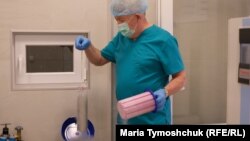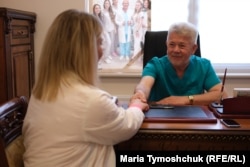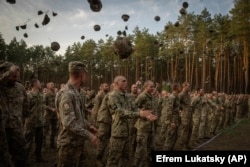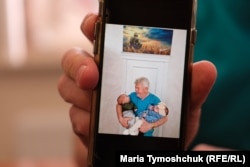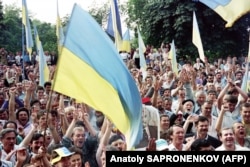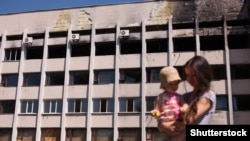LVIV, Ukraine -- When the lights went out at Stefan Khmil’s fertility clinic in Lviv one recent morning, he was quick with a reassurance: The liquid nitrogen tanks that keep sperm, eggs, and embryos at a temperature of around -196 degrees Celsius are safeguarded against blackouts by three separate power generation systems.
That’s good news for Iryna Artysh and her husband, Vasyl, who serves in Ukraine’s air defense forces. He is one of more than 600 soldiers who have had their sperm stored at the clinic at some point since Russia launched its full-scale invasion in February 2022.
Vasyl enlisted immediately after the invasion and was at the front for a year. He is now stationed in the Lviv region but he’s rarely at home, and the couple decided to try artificial insemination in the coming months.
Iryna, a 35-year-old logistics manager, hopes to have a daughter and has already picked out a name: Viktoria. “I believe a Ukrainian victory will come, and everything will be back in its place,” she said.
Meanwhile, though, she lives close to critical infrastructure and military facilities, and she hides in a cellar almost every day when the air-raid sirens go off.
This spring, Russia has once again intensified attacks on Ukraine’s energy infrastructure, doing massive damage and bringing frequent power outages back even to Lviv, near Ukraine’s western border over 1,000 kilometers from the front lines in the east and south.
Despite the distance, the impact of war is felt acutely in Lviv, a relatively safe haven for displaced persons, a rear for the Ukrainian Army, and a hub for business. The city’s population has surpassed 1 million for the first time in its history.
It is also “a reproductive Mecca,” Khmil said, with several advanced clinics operating in the city. His own clinic offers free sperm freezing and artificial insemination for soldiers and their families -- procedures that are increasingly in demand as the war rages on, amplifying concerns about family life and the country's demographic future.
'People Will Return'
In April, the government published a demographic strategy project, and earlier President Volodymyr Zelenskiy had voiced optimism about overcoming the challenges.
"I understand that, when the war ends, there will be a boom. I am confident in this: People will return, they will be confident in the future, confident in the future of Ukraine," he said during a meeting with students in the northeastern city of Sumy in March.
But long before Russia’s full-scale invasion, experts had warned of a looming demographic crisis. Now, with many tens of thousands of Ukrainians killed in the war and millions living abroad or under Russian occupation, negative trends have been exacerbated and the population is shrinking, Volodymyr Landa, an economist from the Center for Economic Strategy who co-authored the government demographic project, told RFE/RL.
Following Russia’s invasion, many fertility clinics in Ukraine began to offer discounts on fertility treatment for soldiers and their partners. In November 2023, Ukraine’s parliament, the Verkhovna Rada, adopted a law allowing for the free collection and preservation of reproductive cells for soldiers. However, since no funds were allocated for it in the 2024 budget, it is expected to start operating in 2025.
According to Khmil, soldiers usually decide to freeze sperm to use it for artificial insemination of their wives or partners. In some cases, they want to preserve the possibility of fathering a child if they become infertile or are killed in the war.
Natalya Fabyan, a 38-year-old bank executive, met Dmytro, a 42-year-old special forces sniper, on a dating app not long after the Russian invasion. They are now married and want to have children, but they hardly ever see each other.
“He was wounded in Soledar,” a site of fierce fighting in the Donbas, “partly lost his hearing, and suffers from PTSD, but he is back in the army,” Natalya said, adding that “stress doesn’t help procreation.”
'Some Part Of Him Will Live On'
According to Khmil, up to 10 percent of severe wounds leave soldiers infertile. Stress, tension, hypothermia, and poor nutrition contribute to the problem, he said.
Natalya and Dmytro hardly ever openly talk about the possibility of him being killed, she said, but it is one of the reasons why they decided to freeze his sperm -- and they sometimes joke about her getting pregnant after his death.
“He says it will be a plus because some part of him will live on,” she said.
The possibility of posthumous conception came into the spotlight when Olena Babych, a specialist in medical law, criticized the legislation initially adopted in November for mandating the destruction of stored genetic material in the event of a soldier's death.
The public outcry led the Verkhovna Rada to adopt an amendment preventing the destruction of gametes and securing funding for their freezing for up to three years after a soldier's death. Ukraine is one of 12 countries where posthumous reproduction is legal.
Khmil described his program as a contribution to the “rebirth of the Ukrainian nation” against the backdrop of what he called “Russia’s barbaric genocide.” But he said that, while freezing genetic material and artificial insemination are becoming more popular among soldiers and their partners, the practice remains too marginal to have a substantial impact on Ukraine’s demographics.
At a demographic forum in Kyiv in April, Social Policy Minister Oksana Zholnovych said Ukraine’s population could drop by up to 10 million by 2050, reaching as low as 25.2 million.
In the first 30 years of independence, Ukraine's population fell from some 51.5 million to around 42 million, according to UN estimates. The decline was mainly due to low birth rates and high migration resulting from economic troubles that set in as the Soviet Union collapsed and deepened after its disintegration.
A decade of Russian aggression against Ukraine -- which started in 2014, when Russia occupied Crimea and fomented armed separatism in the Donbas, then escalated with the full-scale invasion in 2022 -- has left millions of Ukrainians under occupation and forced millions more to flee.
Against that turbulent background, pinning down the population of Ukraine is a tough task, Landa said. The most recent census was carried out in 2001.
As of 2024, some 31 million Ukrainians live on government-controlled territory, including 4.9 million officially registered internally displaced persons, and about 4.9 million are abroad according to the Center for Economic Strategy. According to the Kyiv-based Zmina human rights center, there are at least 5 million Ukrainians living in Russian-occupied territories.
Boom Or Bust
Citing the separation of families, uncertainty about the future, and concerns over safety amid the Russian invasion, Zholnovych told the conference that only 187,000 children were born in Ukraine in 2023, meaning that the country’s fertility rate dropped to about one child per woman. Before the COVID pandemic, in 2020, it was 1.2, and in 2012 it was 1.5 -- in each case below 2.2, the rate that ensures the population does not decline, but in 2012 it was still close to the European Union average of 1.6.
"Our potential postwar 'baby boom' would mean getting back to a European average,” Landa said in reference to Zelenskiy’s comments.
Demographic constraints are among the reasons behind Ukraine’s difficulties in mobilizing new conscripts. In April, after months of wavering, Zelensky signed an unpopular bill lowering the draft age from 27 to 25. Taras Chmut, head of the well-respected Come Back Alive charity foundation called for lowering the age further to 20 but this seems unlikely. Men under 30 are part of the smallest generation in Ukraine’s history and drafting more of them would result in even lower birth rates in the future.
The desperate prognosis led Serhiy Hryvko, a deputy from the ruling Servant of the People party, to propose a “childlessness tax” -- but after a flurry of criticism he promised to withdraw the proposal, which critics likened to natalist policies of the Soviet era.
The government strategy, meanwhile, envisions providing more support for families, encouraging refugees and migrants to return, integrating the internally displaced, and improving health care and education, and other measures.
“In any case, after the war Ukraine will be another country where demographic problems will be entangled with other huge challenges,” Landa said.




